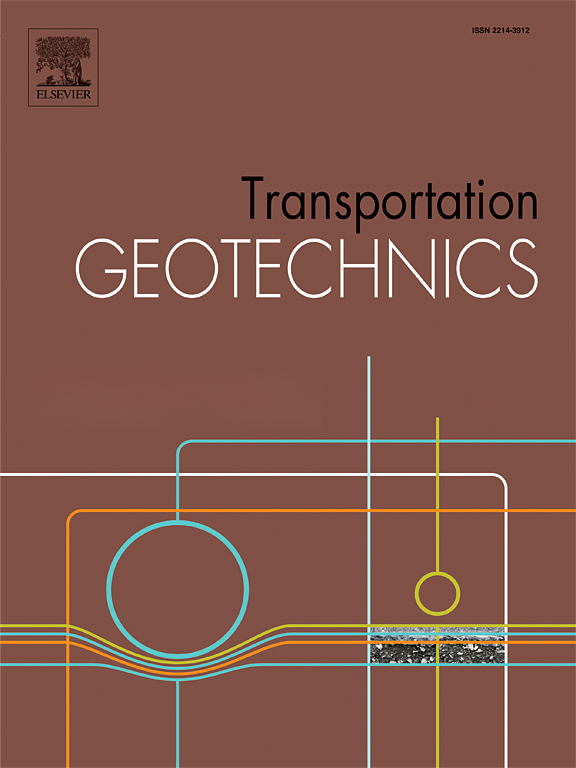粉煤灰和大理石粉稳定粘土的岩土力学特性
IF 5.5
2区 工程技术
Q1 ENGINEERING, CIVIL
引用次数: 0
摘要
研究了f类粉煤灰(FA)和大理岩粉尘(MD)对粘性土岩土力学特性和弹性模量(MR)的单独和联合影响。对含有FA和MD的不同百分比(从0%到12%)的土样进行了一系列密集的实验室测试,包括塑性、膨胀收缩、压实、无侧限抗压强度(UCS)、抗剪强度、加州承受力比(CBR)、循环三轴和微观结构分析。结果表明:添加FA和MD显著降低了土的塑性、自由膨胀和线缩势,而UCS和CBR值上升至6% ~ 9%的阈值后下降;添加FA、MD和它们的组合(FA + MD)分别使土壤的CBR提高了45.1%、55.9%和85.1%。同样,处理7 d的土壤UCS分别提高14.1%、44.0%和72.5%。循环三轴试验中,单独使用FA的MR值最高,增加51.1%。当FA和MD同时使用时,MR值增加了31.6%,相对于单独使用MD时的28.1%的增加。此外,提出了统计模型来预测MR值,并与已有的应用进行了比较评估,从而证实了其相对于传统模型的优越性,为未来的研究人员节省了时间。本文章由计算机程序翻译,如有差异,请以英文原文为准。
Geotechnical characteristics of clayey soil stabilized with fly ash and marble dust
This study investigates the separate and combined impacts of Class-F fly ash (FA) and marble dust (MD) on the geotechnical properties and resilient modulus of clayey soil. An intensive series of laboratory tests, including plasticity, swelling-shrinkage, compaction, unconfined compressive strength (), shear strength, California Bearing Ratio (), cyclic triaxial, and microstructural analyses, were conducted on soil specimens containing FA and MD at different percentages varying from 0 % to 12 %. The results showed that FA and MD additions significantly reduced the plasticity, free swell, and linear shrinkage potential of the soil, whilst and values increased up to a threshold value of 6 % to 9 % and then declined. The incorporation of FA, MD, and their combination (FA + MD) enhanced the soil’s by approximately 45.1 %, 55.9 %, and 85.1 %, respectively. Similarly, the of the soil cured for 7 days improved by 14.1 %, 44.0 %, and 72.5 %, respectively. The cyclic triaxial tests yielded the highest values with FA alone, leading to a 51.1 % increase. When FA and MD were used together, values increased by 31.6 %, which was relatively higher than the 28.1 % increase observed with the use of MD alone. Furthermore, statistical modeling to predict the values was proposed, evaluated comparatively with already available applications, and hereby confirmed its superiority over traditional models to save time for future researchers.
求助全文
通过发布文献求助,成功后即可免费获取论文全文。
去求助
来源期刊

Transportation Geotechnics
Social Sciences-Transportation
CiteScore
8.10
自引率
11.30%
发文量
194
审稿时长
51 days
期刊介绍:
Transportation Geotechnics is a journal dedicated to publishing high-quality, theoretical, and applied papers that cover all facets of geotechnics for transportation infrastructure such as roads, highways, railways, underground railways, airfields, and waterways. The journal places a special emphasis on case studies that present original work relevant to the sustainable construction of transportation infrastructure. The scope of topics it addresses includes the geotechnical properties of geomaterials for sustainable and rational design and construction, the behavior of compacted and stabilized geomaterials, the use of geosynthetics and reinforcement in constructed layers and interlayers, ground improvement and slope stability for transportation infrastructures, compaction technology and management, maintenance technology, the impact of climate, embankments for highways and high-speed trains, transition zones, dredging, underwater geotechnics for infrastructure purposes, and the modeling of multi-layered structures and supporting ground under dynamic and repeated loads.
 求助内容:
求助内容: 应助结果提醒方式:
应助结果提醒方式:


